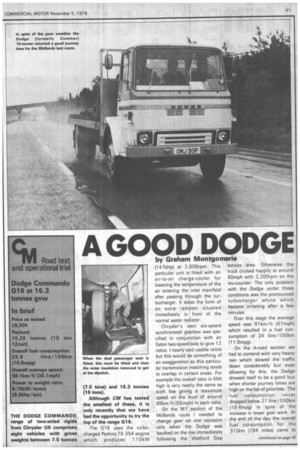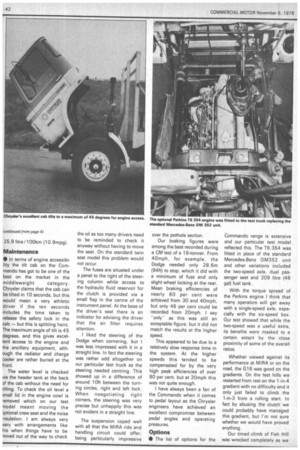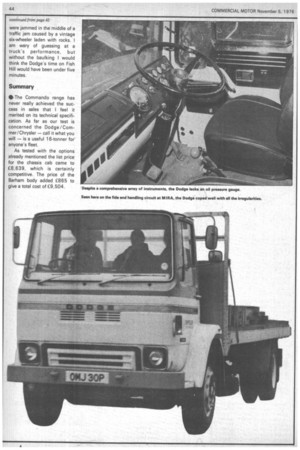A GOOD DODGE
Page 43

Page 44

Page 46

If you've noticed an error in this article please click here to report it so we can fix it.
by Graham Montgomerie
(147bhp) at 2,600rpm. This particular unit is fitted with an air-to-air charge-cooler for lowering the temperature of the air entering the inlet manifold after passing through the turbocharger. It takes the form of an extra radiator situated immediately in front of the normal water radiator.
Chrysler's own six-speed synchromesh gearbox was specified in conjunction with an Eaton two-speed axle to give 12 ratios. I nearly said usable ratios but this would be something of an exaggeration as this particular transmission matching tends to overlap in certain areas. For example the overall ratio in fifth high is very nearly the same as sixth low giving a maximum speed on the level of around 88km/h (55mph) in each ratio.
On the M1 section of the Midlands route I needed to change gear on one occasion only when the Dodge was baulked on the rise immediately following the Watford Gap service area. Otherwise the truck cruised happily at around 60mph with 2,200rpm on the rev-counter. The only problem with the Dodge under these conditions was the pronounced turbocharger whine which became irritating after a few minutes.
Over this stage the average speed was 91km/ h (57mph) which resulted in a fuel consumption of 24 litre/100km (11.8mpg).
On the A-road section we had to contend with very heavy rain which slowed the traffix down considerably but even allowing for this, the Dodge showed itself to be a good buy when shorter journey times are high on the list of priorities. The fuel consumption never dropped below 27 litre/100km (10.4mpg) in spite of the increase in lower gear work. At the end of the day the overall fuel consumption for the 312km (194 miles) came to 25.9 litre/100km (10.9mpg).
Maintenance
• In terms of engine accessibility the tilt cab on the Commando has got to be one of the best on the market in the middleweight category. Chrysler claims that the cab can be tilted in 10 seconds, but this would mean a very athletic driver if the ten seconds includes the time taken to release the safety lock in the cab — but this is splitting hairs. The maximum angle of tilt is 45 degrees, and this gives excellent access to the engine and the ancillary equipment, although the radiator and charge cooler are rather buried at the Front.
The water level is checked via the header tank at the back af the cab without the need for tilting_ To check the oil level a 3rnall lid in the engine cowl is 'emoved which on our test -nodel meant moving the )ptional crew seat and the noise nsulation. I am always very vary with arrangements like his when things have to be noved out of the way to check
the oil as too many drivers need to be reminded to check it anyway without having to move the seat. On the standard twin seat model this problem would not occur.
The fuses are situated under a panel to the right of the steering column while access to the hydraulic fluid reservoir for the clutch is provided via a small flap in the centre of the instrument panel. At the base of the driver's seat there is an indicator for advising the driver that the air filter requires attention.
I liked the steering of the Dodge when cornering, but I was less impressed with it in a straight line. In fact the steering was rather odd altogether on our particular test truck as the steering needed centring. This showed up in a difference of around 10ft between the turning circles, right and left lock. When noegotiating tight corners, the steering was very precise but unhappily this was not evident in a straight line.
The suspension coped well with all that the MIRA ride and handling circuit could offer, being particularly impressive over the pothole section.
Our braking figures were among the best recorded during a CM test of a 16-tonner. From 40mph, for example, the Dodge needed only 28.6m (94ft) to stop, which it did with a minimum of fuss and only slight wheel locking at the rear. Mean braking efficiencies of nearly 60 per cent were achieved from 30 and 40mph, but only 46 per cent could be recorded from 20mph. I say "only" as this was still an acceptable figure, but it did not match the results at the higher speed.
This appeared to be due to a relatively slow response time in the system. At the higher speeds this tended to be compensated for by the very high peak efficiencies of over 80 per cent, but at 20mph this was not quite enough.
I have always been a fan of the Commando when it comes to pedal layout as the Chrysler engineers have achieved an excellent compromise between pedal angles and operating pressures.
.Options • The list of options for the Commando range is extensive and our particular test model reflected this. The T6.354 was fitted in place of the standard Mercedes-Benz 0M352 unit and other variations included the two-speed axle, dual passenger seat and 209 litre (46 gal) fuel tank.
With the torque spread of the Perkins engine I think that many operators will get away with a single-speed axle, especially with the six-speed box. Our test showed that while the two-speed was a useful extra, its benefits were masked to a certain extent by the close proximity of some of the overall ratios.
Whether viewed against its performance at MIRA or on the road, the G16 was good on the gradients. On the test hills we restarted from rest on the 1-in-4 gradient with no difficulty and it only just failed to climb the 1-in-3 from a rolling start. In fact by abusing the clutch we could probably have managed this gradient, but I'm not sure whether we would have proved anything.
Our timed climb of Fish Hill was wrecked completely as we were jammed in the middle of a traffic jam caused by a vintage six-wheeler laden with rocks. I am wary of guessing at a truck's performance, but without the baulking I would think the Dodge's time on Fish Hill would have been under five minutes.
Summary II1The Commando range has never really achieved the success in sales that I feel it merited on its technical specification. As far as our test is concerned the Dodge/Commer/Chrysler — call it what you will — is a useful 16-tonner for anyone's fleet.
As tested with the options already mentioned the list price for the chassis cab came to £8,639, which is certainly competitive. The price of the Barham body added £865 to give a total cost of £9,504.
































































































